Leadership Practice: Personal Experiences and Critical Analysis
VerifiedAdded on 2023/06/05
|5
|1114
|272
Essay
AI Summary
This essay provides a reflection on professional leadership practices, drawing on the student's personal experiences as a counselor working with drug addiction among youths. The student details a situation where they attempted a different leadership approach by reaching out to the addicts directly, facing opposition and rejection from team members and the target group. The essay explores the pressures to conform, the importance of speaking up for one's beliefs, and the introduction of new perspectives in group discussions. The student emphasizes the significance of taking a critical perspective on leadership and diversity to make decisions that consider the interests of all group members, ultimately advocating for inclusive and representative leadership. The student's experience highlights the challenges and rewards of innovative leadership and the importance of standing firm in one's convictions to achieve positive outcomes.
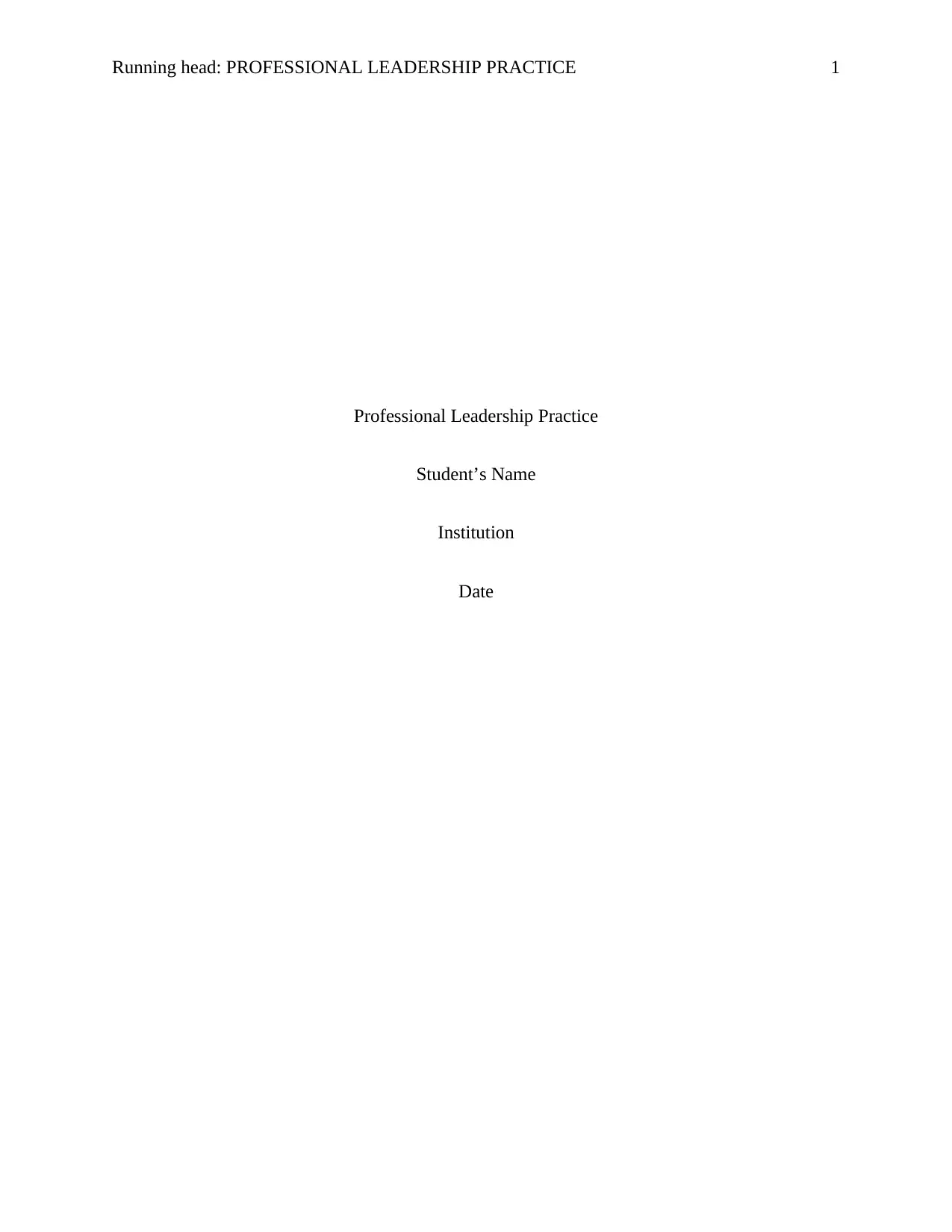
Running head: PROFESSIONAL LEADERSHIP PRACTICE 1
Professional Leadership Practice
Student’s Name
Institution
Date
Professional Leadership Practice
Student’s Name
Institution
Date
Paraphrase This Document
Need a fresh take? Get an instant paraphrase of this document with our AI Paraphraser
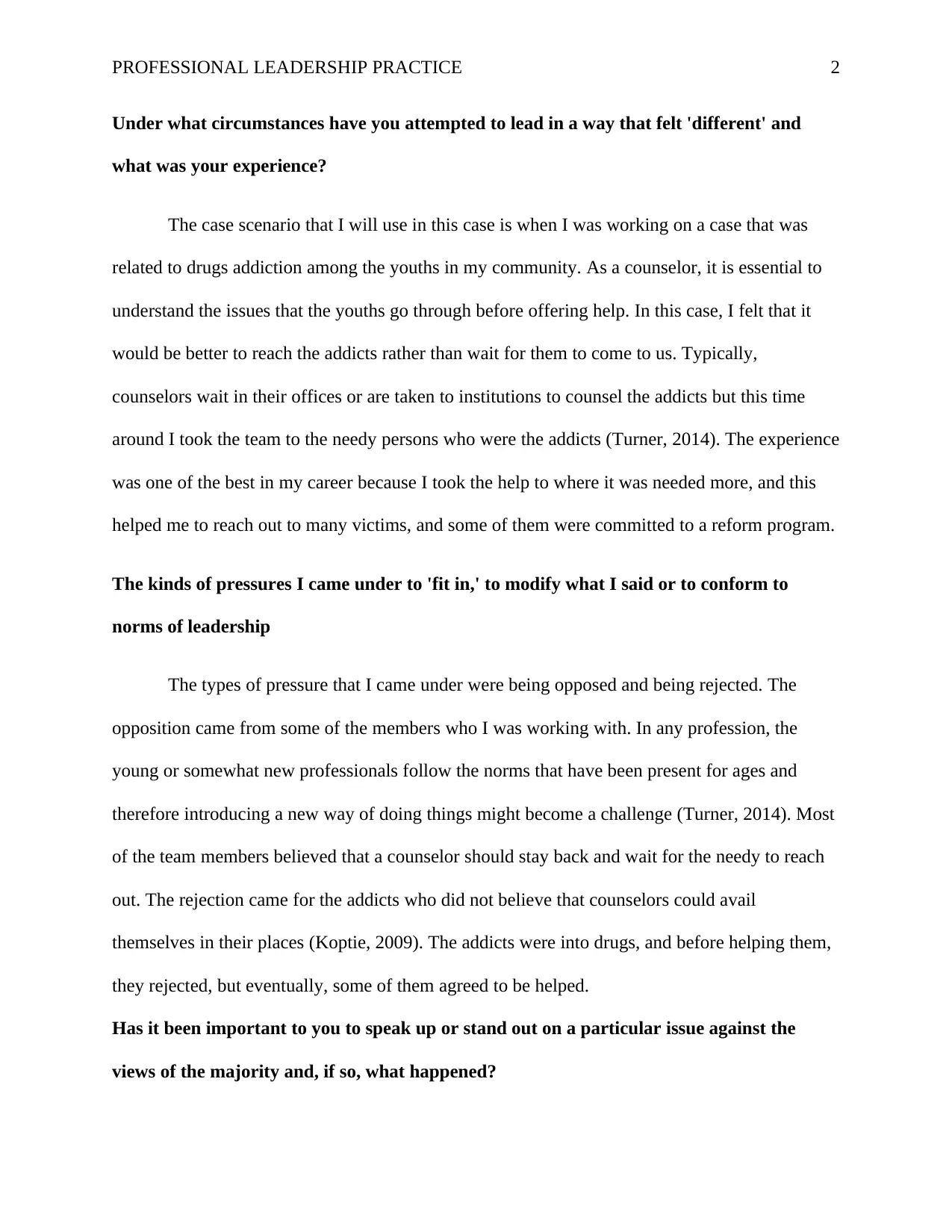
PROFESSIONAL LEADERSHIP PRACTICE 2
Under what circumstances have you attempted to lead in a way that felt 'different' and
what was your experience?
The case scenario that I will use in this case is when I was working on a case that was
related to drugs addiction among the youths in my community. As a counselor, it is essential to
understand the issues that the youths go through before offering help. In this case, I felt that it
would be better to reach the addicts rather than wait for them to come to us. Typically,
counselors wait in their offices or are taken to institutions to counsel the addicts but this time
around I took the team to the needy persons who were the addicts (Turner, 2014). The experience
was one of the best in my career because I took the help to where it was needed more, and this
helped me to reach out to many victims, and some of them were committed to a reform program.
The kinds of pressures I came under to 'fit in,' to modify what I said or to conform to
norms of leadership
The types of pressure that I came under were being opposed and being rejected. The
opposition came from some of the members who I was working with. In any profession, the
young or somewhat new professionals follow the norms that have been present for ages and
therefore introducing a new way of doing things might become a challenge (Turner, 2014). Most
of the team members believed that a counselor should stay back and wait for the needy to reach
out. The rejection came for the addicts who did not believe that counselors could avail
themselves in their places (Koptie, 2009). The addicts were into drugs, and before helping them,
they rejected, but eventually, some of them agreed to be helped.
Has it been important to you to speak up or stand out on a particular issue against the
views of the majority and, if so, what happened?
Under what circumstances have you attempted to lead in a way that felt 'different' and
what was your experience?
The case scenario that I will use in this case is when I was working on a case that was
related to drugs addiction among the youths in my community. As a counselor, it is essential to
understand the issues that the youths go through before offering help. In this case, I felt that it
would be better to reach the addicts rather than wait for them to come to us. Typically,
counselors wait in their offices or are taken to institutions to counsel the addicts but this time
around I took the team to the needy persons who were the addicts (Turner, 2014). The experience
was one of the best in my career because I took the help to where it was needed more, and this
helped me to reach out to many victims, and some of them were committed to a reform program.
The kinds of pressures I came under to 'fit in,' to modify what I said or to conform to
norms of leadership
The types of pressure that I came under were being opposed and being rejected. The
opposition came from some of the members who I was working with. In any profession, the
young or somewhat new professionals follow the norms that have been present for ages and
therefore introducing a new way of doing things might become a challenge (Turner, 2014). Most
of the team members believed that a counselor should stay back and wait for the needy to reach
out. The rejection came for the addicts who did not believe that counselors could avail
themselves in their places (Koptie, 2009). The addicts were into drugs, and before helping them,
they rejected, but eventually, some of them agreed to be helped.
Has it been important to you to speak up or stand out on a particular issue against the
views of the majority and, if so, what happened?
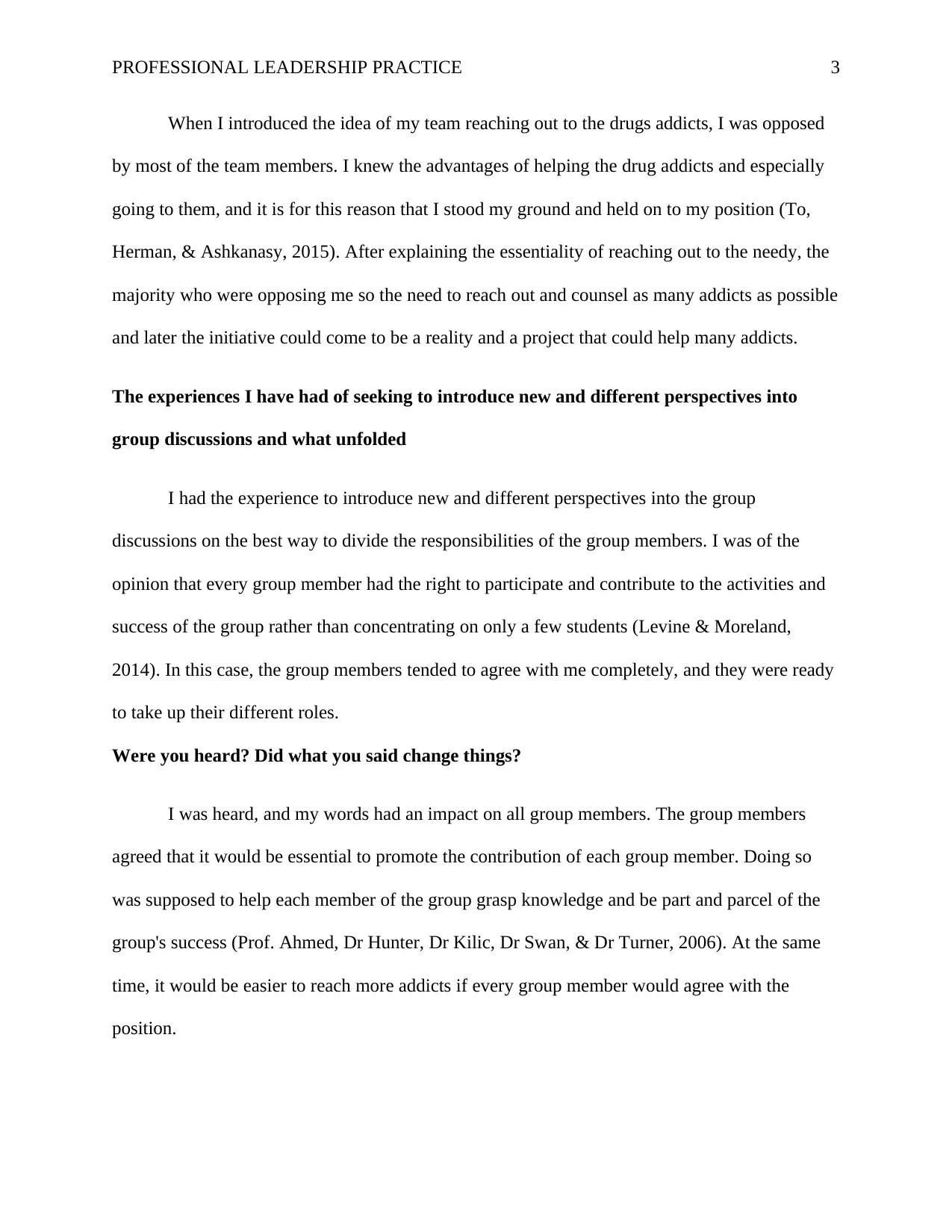
PROFESSIONAL LEADERSHIP PRACTICE 3
When I introduced the idea of my team reaching out to the drugs addicts, I was opposed
by most of the team members. I knew the advantages of helping the drug addicts and especially
going to them, and it is for this reason that I stood my ground and held on to my position (To,
Herman, & Ashkanasy, 2015). After explaining the essentiality of reaching out to the needy, the
majority who were opposing me so the need to reach out and counsel as many addicts as possible
and later the initiative could come to be a reality and a project that could help many addicts.
The experiences I have had of seeking to introduce new and different perspectives into
group discussions and what unfolded
I had the experience to introduce new and different perspectives into the group
discussions on the best way to divide the responsibilities of the group members. I was of the
opinion that every group member had the right to participate and contribute to the activities and
success of the group rather than concentrating on only a few students (Levine & Moreland,
2014). In this case, the group members tended to agree with me completely, and they were ready
to take up their different roles.
Were you heard? Did what you said change things?
I was heard, and my words had an impact on all group members. The group members
agreed that it would be essential to promote the contribution of each group member. Doing so
was supposed to help each member of the group grasp knowledge and be part and parcel of the
group's success (Prof. Ahmed, Dr Hunter, Dr Kilic, Dr Swan, & Dr Turner, 2006). At the same
time, it would be easier to reach more addicts if every group member would agree with the
position.
When I introduced the idea of my team reaching out to the drugs addicts, I was opposed
by most of the team members. I knew the advantages of helping the drug addicts and especially
going to them, and it is for this reason that I stood my ground and held on to my position (To,
Herman, & Ashkanasy, 2015). After explaining the essentiality of reaching out to the needy, the
majority who were opposing me so the need to reach out and counsel as many addicts as possible
and later the initiative could come to be a reality and a project that could help many addicts.
The experiences I have had of seeking to introduce new and different perspectives into
group discussions and what unfolded
I had the experience to introduce new and different perspectives into the group
discussions on the best way to divide the responsibilities of the group members. I was of the
opinion that every group member had the right to participate and contribute to the activities and
success of the group rather than concentrating on only a few students (Levine & Moreland,
2014). In this case, the group members tended to agree with me completely, and they were ready
to take up their different roles.
Were you heard? Did what you said change things?
I was heard, and my words had an impact on all group members. The group members
agreed that it would be essential to promote the contribution of each group member. Doing so
was supposed to help each member of the group grasp knowledge and be part and parcel of the
group's success (Prof. Ahmed, Dr Hunter, Dr Kilic, Dr Swan, & Dr Turner, 2006). At the same
time, it would be easier to reach more addicts if every group member would agree with the
position.
⊘ This is a preview!⊘
Do you want full access?
Subscribe today to unlock all pages.

Trusted by 1+ million students worldwide
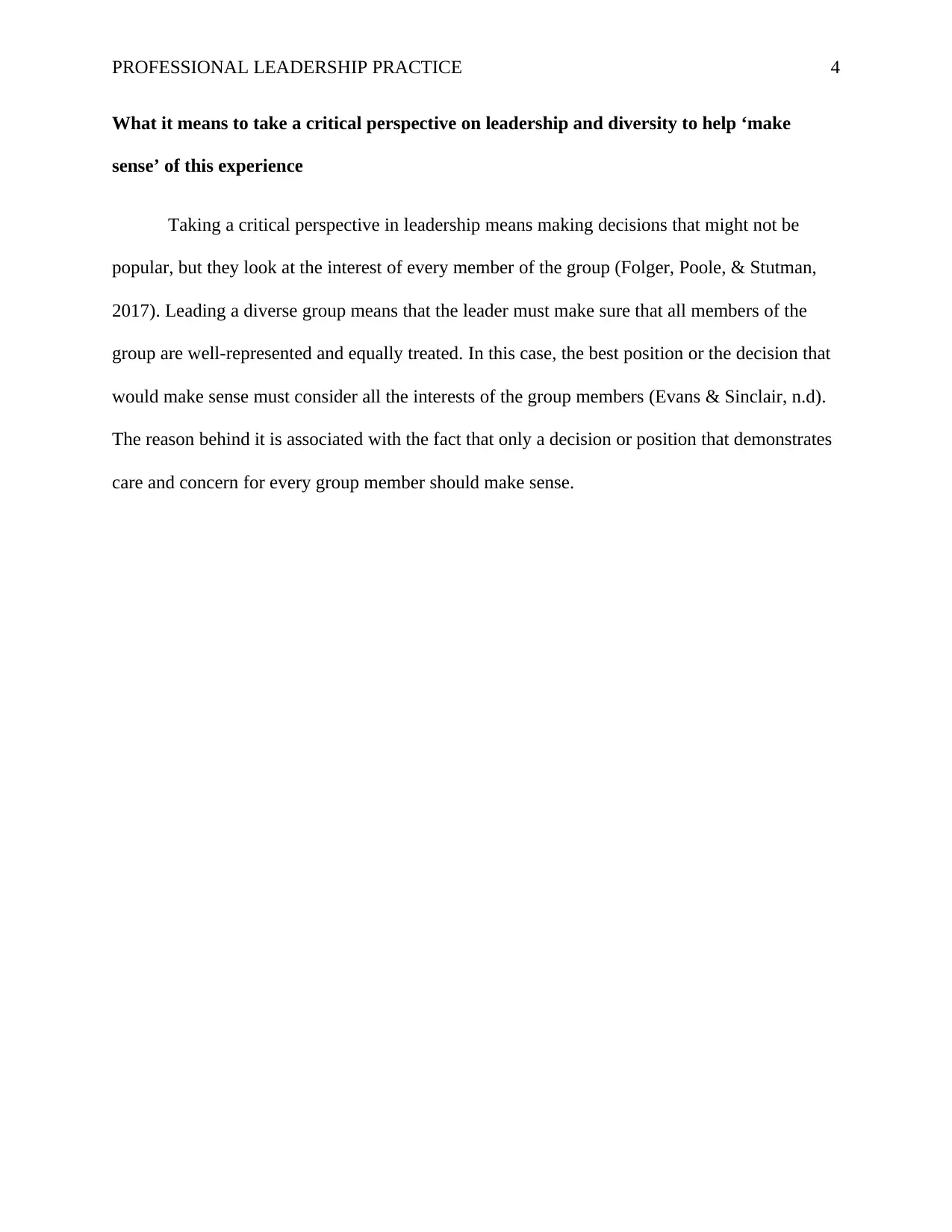
PROFESSIONAL LEADERSHIP PRACTICE 4
What it means to take a critical perspective on leadership and diversity to help ‘make
sense’ of this experience
Taking a critical perspective in leadership means making decisions that might not be
popular, but they look at the interest of every member of the group (Folger, Poole, & Stutman,
2017). Leading a diverse group means that the leader must make sure that all members of the
group are well-represented and equally treated. In this case, the best position or the decision that
would make sense must consider all the interests of the group members (Evans & Sinclair, n.d).
The reason behind it is associated with the fact that only a decision or position that demonstrates
care and concern for every group member should make sense.
What it means to take a critical perspective on leadership and diversity to help ‘make
sense’ of this experience
Taking a critical perspective in leadership means making decisions that might not be
popular, but they look at the interest of every member of the group (Folger, Poole, & Stutman,
2017). Leading a diverse group means that the leader must make sure that all members of the
group are well-represented and equally treated. In this case, the best position or the decision that
would make sense must consider all the interests of the group members (Evans & Sinclair, n.d).
The reason behind it is associated with the fact that only a decision or position that demonstrates
care and concern for every group member should make sense.
Paraphrase This Document
Need a fresh take? Get an instant paraphrase of this document with our AI Paraphraser
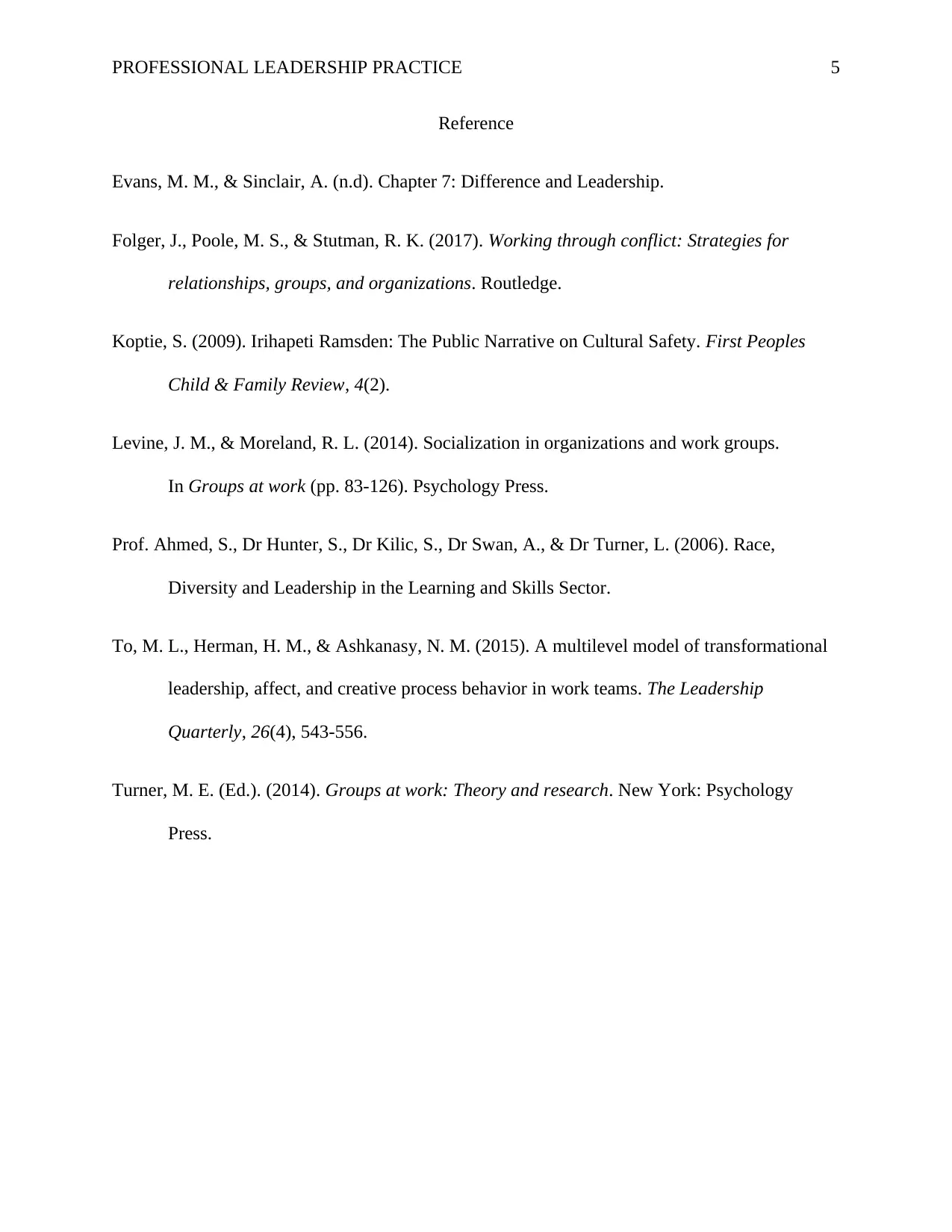
PROFESSIONAL LEADERSHIP PRACTICE 5
Reference
Evans, M. M., & Sinclair, A. (n.d). Chapter 7: Difference and Leadership.
Folger, J., Poole, M. S., & Stutman, R. K. (2017). Working through conflict: Strategies for
relationships, groups, and organizations. Routledge.
Koptie, S. (2009). Irihapeti Ramsden: The Public Narrative on Cultural Safety. First Peoples
Child & Family Review, 4(2).
Levine, J. M., & Moreland, R. L. (2014). Socialization in organizations and work groups.
In Groups at work (pp. 83-126). Psychology Press.
Prof. Ahmed, S., Dr Hunter, S., Dr Kilic, S., Dr Swan, A., & Dr Turner, L. (2006). Race,
Diversity and Leadership in the Learning and Skills Sector.
To, M. L., Herman, H. M., & Ashkanasy, N. M. (2015). A multilevel model of transformational
leadership, affect, and creative process behavior in work teams. The Leadership
Quarterly, 26(4), 543-556.
Turner, M. E. (Ed.). (2014). Groups at work: Theory and research. New York: Psychology
Press.
Reference
Evans, M. M., & Sinclair, A. (n.d). Chapter 7: Difference and Leadership.
Folger, J., Poole, M. S., & Stutman, R. K. (2017). Working through conflict: Strategies for
relationships, groups, and organizations. Routledge.
Koptie, S. (2009). Irihapeti Ramsden: The Public Narrative on Cultural Safety. First Peoples
Child & Family Review, 4(2).
Levine, J. M., & Moreland, R. L. (2014). Socialization in organizations and work groups.
In Groups at work (pp. 83-126). Psychology Press.
Prof. Ahmed, S., Dr Hunter, S., Dr Kilic, S., Dr Swan, A., & Dr Turner, L. (2006). Race,
Diversity and Leadership in the Learning and Skills Sector.
To, M. L., Herman, H. M., & Ashkanasy, N. M. (2015). A multilevel model of transformational
leadership, affect, and creative process behavior in work teams. The Leadership
Quarterly, 26(4), 543-556.
Turner, M. E. (Ed.). (2014). Groups at work: Theory and research. New York: Psychology
Press.
1 out of 5
Related Documents
Your All-in-One AI-Powered Toolkit for Academic Success.
+13062052269
info@desklib.com
Available 24*7 on WhatsApp / Email
![[object Object]](/_next/static/media/star-bottom.7253800d.svg)
Unlock your academic potential
Copyright © 2020–2025 A2Z Services. All Rights Reserved. Developed and managed by ZUCOL.




